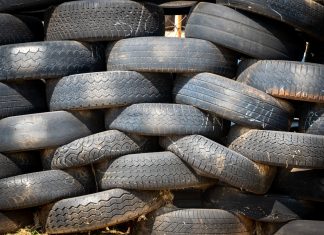| Issue #81 • May/June, 2003 |
When the subject of preparedness comes up, do you think of having a stock of supplies in your kitchen pantry in case of a storm? Maybe a backpack in your office or the trunk of your car with the things you’d need until you could return home?
If you travel for business or pleasure, the concept is likely to apply to an unfamiliar city thousands of miles from home. Being ready for the unexpected while traveling will give you options you wouldn’t otherwise have. Sometimes what might have been overwhelming becomes merely an inconvenience, or even an adventure.
So what should we anticipate? Consider what has affected travelers before us: natural disasters, transportation strikes, civil unrest, crime, epidemics, quarantines, terrorism, war. Things as common as snow, traffic jams, flight cancellations, or car accidents. Things as local as a bridge hit by a barge, a derailed commuter train, or a power outage. Things of magnitudes beyond our comprehension like the 1985 Mexico City earthquake, Mount St. Helens, the Mississippi flood of 1993, Chernobyl, the New England blizzard of 1978, the hurricane that killed 6,000 in Galveston in 1900, wars that involved the entire world.
Anything your imagination can conceive of, and even more things that it can’t. Being prepared might not always be enough for every circumstance, but anything that improves your odds is better than nothing.
I once spent three days in the Nashville airport during a snow storm. There were no hotel rooms available at any price. Airport personnel provided hundreds of cots, but there weren’t nearly enough to go around. The junk food from the kiosks in the terminal was gone within hours.
|
Immediately after hurricane Andrew, I was holed up in a Miami hotel room with no running water, watching from the balcony as looters smashed windows below. I ended up using water from the toilet tank. (RelaxI said the tank, not the bowl.)
I have acquaintances who were stranded at a ski resort in Utah when an avalanche closed the only road out.
During the New England blizzard of 1978, hundreds of people spent days in their cars on Rt. 128 around Boston. A friend was in a grocery store during the San Francisco earthquake of 1989. The roads and bridges to her home were destroyed. Another friend was trapped by a revolution in Guinea-Bissauanarchy that didn’t even make the news in a country that no one’s heard of.
Tens of thousands of airline passengers on 9/11 were diverted to places without accommodations for them, and deplaned without their luggage. (Hearing about the hospitality they experienced in places like Gander, Newfoundland, restored some of my jaded faith in the nature of people.)
My family physician volunteered for a U.N. humanitarian mission to Congo. Rebels paid the hospital a visit, and he was the sole Caucasian survivor. (Hearing about that jaded my faith again.) He survived because he was alert to what was happening around him and prepared to act. Something that extreme will probably never happen to you. He didn’t think it would ever happen to him, either.
As a gentleman from the destroyed city of Sarajevo said “War is like bad weather. It just comes.”
When I read about disasters in the news, or watch them unfolding in living color on TV, I think about what those people would want if they could magically go back in time for a “do-over.” What needs seem common to most times and places? Water first, usually. Then appropriate clothes, and then shelter and food. Sometimes medical help and protection.
General preparedness
Clothing is your first layer of shelter. Pack for what’s expected, of course, but anticipate more. A trip might start in Miami and end in Fairbanks. Dress appropriately, not only for your destination, but for possible diversions along the way, unnatural weather extremes, heating or air conditioning problems, and extended stays.
Synthetics are warm and they dry quickly, but will do skin damage if they melt. (I’m a little paranoid about this as I’ve seen it happen.) Natural fibers are a better choice if fire is a hazardand it is in your car, mowing your lawn, starting a barbecue, or going to a nightclub.
Cotton is comfortable, but loses its insulating value if it gets wet, and it dries slowly. Wool provides some warmth even when wet, but gets heavy and some types are itchy. Silk combines the best attributes of both, and is my favorite first layer. It can be washed in a sink by hand at the end of a day, and will dry overnightboth you and your travel companions will appreciate that if your one-day trip becomes a five-day trip.
Impractical shoes are the biggest clothing mistake I see travelers making. I love the look of a woman in heels, for example, but the leggy girl of your dreams will wear on you pretty quickly when her feet start to hurt. Bring along something comfortable just in case there’s walking to be done.
“Carry-on” preparedness
Airline travelers have the highest standard of resourcefulness to meet in order to be prepared. Not everything you’d like to have when things get difficult will fit in checked luggage, let alone in carry-on bags. The Transportation Security Administra-tion (TSA), a government agency that helps terrorists by disarming the 282 million of us who don’t want to go on a suicide ride (but that’s another article), won’t allow so much as a Swiss Army knife onboard. Before a recent international flight, even nail clippers and a book of matches were confiscated from me. An elderly woman behind me had her sewing needles taken. (Of course, if a weapon were ever needed by either a terrorist or a law-abiding citizen, one can always be improvised. So far, at least, a can of soup in a sock isn’t illegal.)
Personally, I’m armed wherever it’s legal for me to be so. Armed or not, don’t attract attention to yourself by acting like easy prey. Behave confidently but inconspicuously. In third-world countries, don’t be a loud, rich American wearing expensive jewelry. Keep your wallet in a button-down pocket, and some of your money in a money belt or an ankle pouch. Make a copy of things like your passport information and keep it in a separate place. Ask your hotel’s concierge about neighborhoods to avoid, and have them choose a taxi for you. Ask for a room above the ground floor. Most problems can be avoided simply by being alert, but consider taking a self defense course.
|
When I fly somewhere, I feel naked without at least a pocket knife. It’s permissible to take one in your checked baggage. If you have only carry-on luggage, an inexpensive one may be purchased at your destination. Use it while you’re there, then make someone’s day by giving it away when you leave. In any case, I take a small course-grit diamond sharpening stone. It’s weight and bulk are negligible. If necessary, even a scrounged piece of metal or plastic could be sharpened.
Keep a bottle of water in your carry-on, and top it off it when opportunities arise. The collapsible kind takes up less space and won’t slosh annoyingly if you squeeze the air out. I bring a water filter or iodine crystals, too. You might not always be able to get water out of a tap. Pack some lightweight, nutritious, compact food. You’re still free to patronize restaurants if that’s your choice, but you won’t be forced to rely on them.
Ear plugs and an eye mask will help you get some sleep on a crowded bus or plane. Other essentials for my “carry-on survival kit” are a toothbrush and floss, sunscreen, sunglasses, one of those candles-in-a-can, disposable lighter, a small first-aid kit (if you take medication, bring extra), a tiny LED flashlight or headlamp, and above all else: a good book. Something like, oh, say, a Backwoods Home Anthology.
Terrorism
Terrorism is making headlines these days, although it’s probably less likely than weather or petty crime to disrupt your vacation or business trip. According to a recent news show, many people are buying gas masks. The odds of needing one, however, are miniscule. Unless you have sophisticated detection devices, the odds of knowing when you need one are even more miniscule. Visible clouds of biological or nerve agents don’t roll down the street like in the movies.
Even if you do have a genuine need for a gas mask, and know when it’s necessary to wear it and when it’s safe to remove it, and even if you are trained in its use, it still must be instantly available, properly fitted, and with fresh filters of the proper type. For agents that can be absorbed through the skin, special suits are also necessary. Your money can be better spent.
I once read that the greatest risks to an airline pilot on the job are traffic accidents during the drive to the airport, and hotel fires during the layover. The same probably holds true for most passengers.
Automobile preparedness
Operate your car as if your life depends on it, because it does. Drive with common sense and at sane speeds. Make sure the next car you buy is crashworthy. (Common sense and sane speeds only count for so much if you’re in a cat-food can.) Wear your seat belt. Have a fire extinguisher and a first aid kit. Know where they are and how to use them.
A duffel in my car also contains a sleeping bag, insulated ground pad, saw, jumper cables, tow strap, first aid kit, flashlight, a pot for cooking or melting snow, an ice scraper, and a couple of MREs (the military meals, ready-to-eat). I have used all of those things. I replace the MREs every year. (Want to make friends with the neighborhood kids? Give them your old MRE’s. They’ll be fascinated by them.)
Throw in whatever’s appropriate for changing seasons, forecasts, or local conditions. In winter I add a hat, mittens, boots, shovel, and snowshoes. A candle or two will keep a stalled car reasonably warm. Be careful with fire, of course, so the solution doesn’t become worse than the problem. A cell phone can summon help and reassure family. Keep your car’s gas tank as full as is practicalit costs the same as leaving it empty, and again that phrase: It gives you more options.
A bicycle in the trunk, with an air pump and a spare inner tube, is my favorite automotive insurance. Walking a few miles with anything to carry is a time-consuming ordeal. On a bike, twice as far with twice the load is a pleasant outing.
Hotels
When you check into a hotel, make it a habit to look at the fire escape route posted on the inside of your room’s door. Then open your door and look at the route the way you will look at it at 3 a.m. when you’ve been suddenly roused from a sound sleep. Count the number of doors and corners to get to it in case darkness or smoke prevent you from being able to see. (Do the same thing, while we’re at it, when you board a plane, ship, or train: familiarize yourself with the way out. Count the rows of seats to it so you could get there in the dark, and look at how the doors or hatches operate.)
Don’t use elevators during a fire because a power failure may immobilize them. Smoke tends to hug the ceiling. If it becomes a problem, stay close to the floor. (So why are the fire exit signs at the tops of the doors?)
If a fire alarm sounds while you’re in your room, feel the door. If it isn’t hot and you don’t see smoke or flames through the peephole, evacuate. Remember to take your room key in case you must retreat to your room again. If you can’t open the door, fill the bathtub with water and seal openings that smoke may come through with soaked towels. Breaking windows might create a draft that brings smoke in, so it’s a last resort. Sit tight if you’re more than a couple of stories above the ground. Most fires are confined to a few rooms or floors. We have a natural fear of fire, but smoke and panic are usually the greater threats.
I suspect that for most of the readers of this magazine, the concept of being prepared isn’t new. But I hope this article has stimulated some thought and encouraged you to be alert and resourceful. Above all, being prepared is an attitude.















